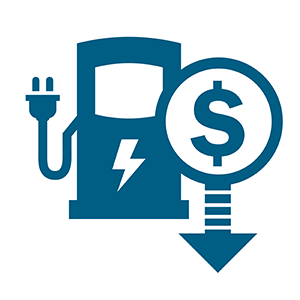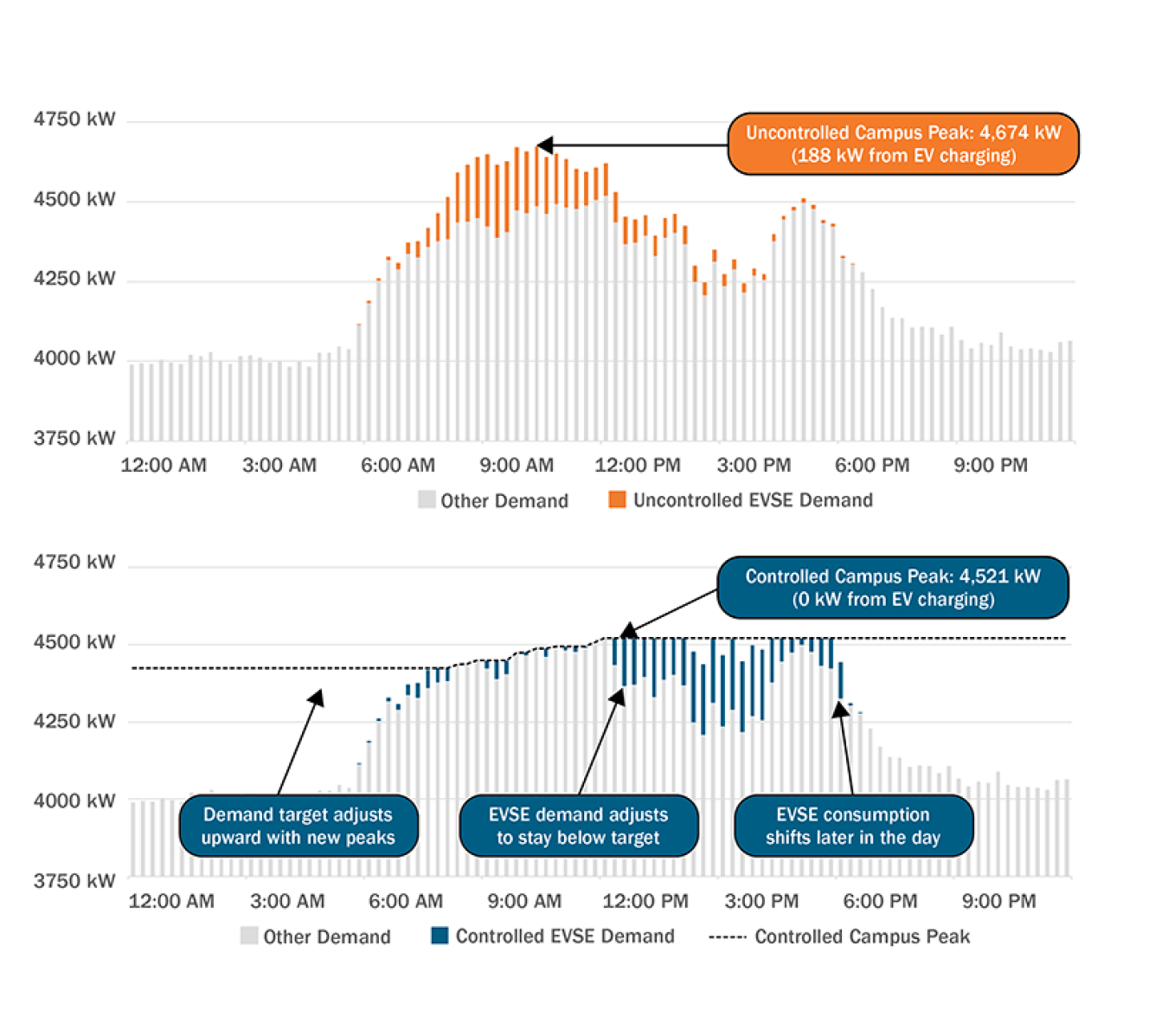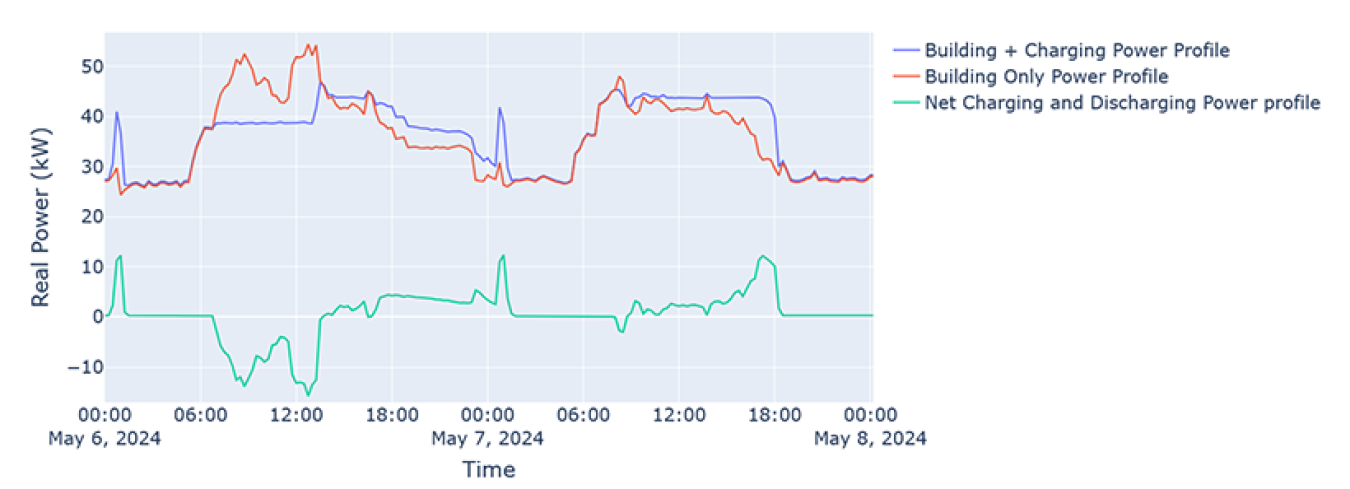Smart charge management (SCM) is the dynamic coordinated control of electric vehicle (EV) charging to mitigate the challenges of costly upgrades and delayed EV charging station deployment due to a lack of distribution grid capacity. Through various communication protocols, mentioned in the SCM implementation pathway, SCM facilitates communication among EVs, EV charging stations, building loads, fleet operations, and utilities. This exchange of information enables the dynamic control of EV charging in response to high charging demand or building loads, dynamic energy rates, and variable fleet operations. By connecting these elements, SCM enables monitoring, management, and charge session optimization to achieve:
- Reduced EV charger installation costs and timelines by mitigating costly upgrades
- Reduced charging electricity costs by avoiding peak pricing or demand charges
- Optimized fleet operations to ensure each vehicle receives the energy it needs
- Support for connected loads during extreme events.
To function effectively, SCM requires seamless communication and integration among all the connected loads, in addition to operational data for EVs and charging stations such as schedule, battery state of charge, dwell periods, and information on varying electricity rates, if applicable.
Applications and Benefits
Fleets of all sizes can benefit from smart charge management; however, its benefits become more pronounced as EV fleets grow and when integrated with other building loads, fleet operations, and systems like telematics and scheduling platforms. SCM can provide the following benefits.
 Reduce EV Charger Installation Costs and Timelines
Reduce EV Charger Installation Costs and Timelines
SCM can make use of existing electrical and EV charging infrastructure without putting strain on local grids. It can help fleets:
- Reduce grid and distribution infrastructure (transformer, service panel) upgrade costs and time
- Avoid installation of new equipment by managing charging within existing capacity
- Enforce power ceilings by coordinating all EV charging to reduce coincidence peak
- Optimize fleet operations and vehicle energy needs to avoid delays.
 Reduce Charging Electricity Costs
Reduce Charging Electricity Costs
SCM can help reduce the electricity cost of charging EVs by:
- Scheduling charging during off-peak periods when electricity rates are lower
- Reducing coincident peaks between EV charging and facility operations to mitigate demand charges as shown in Figure 1
- Facilitating vehicle-to-grid discharge services (also known as bidirectional charging) for additional revenue streams or reducing demand charges in the monthly electricity bill
- Participating in utility demand response programs to reduce charging on-demand
- Reducing repair/replacement costs through centralized power management
- Integrating with distributed energy resources (DERs) like renewables to avoid PV curtailment or maximize the use of local energy
- Reducing downstream greenhouse gas emission impacts by prioritizing cleaner energy sources for charging.
Distributed Energy Resource: A relatively small-scale unit of power generation such as solar, wind, battery energy storage system, or even an EV that is connected to a larger power grid at the distribution level.

Figure 1. Smart workplace charging management spreads out electric vehicle charging to avoid peaks and maximize use of solar power. This example shows over 100 workplace chargers having their loads shifted away from midday when solar energy is available, and then ramping up charging in the later afternoon after the solar peak has passed. Illustration adapted from the NREL report, Integrating Electric Vehicle Charging Infrastructure into Commercial Buildings and Mixed-Use Communities: Design, Modeling, and Control Optimization Opportunities.
 Optimize Fleet Operations
Optimize Fleet Operations
SCM can make use of telematics and scheduling needs for dynamic demand and supply planning to achieve:
- Optimal vehicle uptime and utilization
- Automated charging that provides adequate state-of-charge by the next vehicle deployment
- Insight into whether EV charging station expansion is required or vehicle assets are underutilized.
 Support Connected Loads During Extreme Events
Support Connected Loads During Extreme Events
During extreme events, if the grid is down or unable to provide sufficient power needs, SCM can support connected building loads by utilizing EVs as mobile energy storage and distribution units utilizing vehicle-to-grid capabilities. This can also potentially reduce peak demand costs. Figure 2 shows a federal building testing vehicle-to-grid technology. The orange line shows the building power demand. The blue line is the combined power demand from the building and the charging. From approximately 6:30 a.m. to 12:30 p.m. on May 6, 2024, the vehicle provided power to the building, reducing the peak demand of over 50 kW to under 40 kW.

Figure 2. This figure indicates how vehicles can reduce peak demand during peak demand or extreme events to support local loads.

